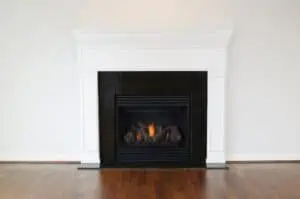How Does a Ventless Fireplace Work?
A ventless fireplace is a gas-burning unit that doesn’t require a chimney or flue. It pipes natural gas or liquid propane directly into its burners, which burn the fuel cleanly and without much exhaust.
(Looking for a”repair for gas fireplace“? Contact us Today!)

They can be designed in a variety of ways, ranging from double-sided or single-sided to an insert, and they typically come in various sizes to suit most room sizes. They are usually very cost-effective compared to other forms of fireplaces, and they are easy to install.
Most gas and propane ventless fireplaces use artificial ceramic fiber logs to mimic a wood-burning fire, with the option of adding lava rocks or colored glass pieces for a more decorative appearance. Some models also feature sand granules or glowing embers to simulate the look of a natural wood-burning fireplace.
There are many different types of ventless gas fireplaces on the market, and you can choose from models that are available at a wide range of prices. The price difference varies based on size, materials used, and whether the model is custom-built or prefabricated.
Some ventless gas fireplaces even use gel canisters for fuel, which are not only less expensive than gas or propane options but don’t require any plumbing at all. You can find ventless gel-powered fireplaces for as little as $500 to $800.
These types of units are a great way to add a touch of warmth and elegance to any space, and they’re a popular choice among homeowners who don’t want the hassle of a chimney or flue. They can be installed in many rooms and are particularly ideal for small homes, apartments, and high-rise condos where a chimney would be difficult to install.
If you are installing a gas or propane ventless fireplace, it’s important to check your local building and health codes to ensure you meet the requirements. It’s also a good idea to have a licensed professional install the unit, as some areas are more strict than others.
The National Fire Protection Association and the United States Environmental Protection Agency recommend that you have your gas-burning ventless fireplace inspected annually by a certified contractor to ensure it’s operating safely. This includes checking and adjusting oxygen and carbon monoxide monitors, as well as cleaning or replacing the log set and media bed.
Although most vent-less fireplaces are designed to reduce toxic fumes, there are still some byproducts produced during combustion that can be harmful if inhaled. That’s why it’s a good idea to run them for short periods of time and make sure you have a window open to allow fresh air to enter the room.
Some ventless fireplaces are equipped with built-in oxygen-depletion sensors that shut the unit off if they detect low oxygen levels in the room. This prevents the release of dangerous gases into your home and keeps you safe from carbon monoxide exposure, which can be fatal if left untreated.
A ventless fireplace can also produce water vapor as a byproduct of the combustion process, and this can result in higher humidity levels inside your home. This can cause mold to grow, which could trigger asthma symptoms in some people. Depending on the size and type of the unit, this can be a problem that’s easily remedied with a dehumidifier or cracking a window to let more air in.

